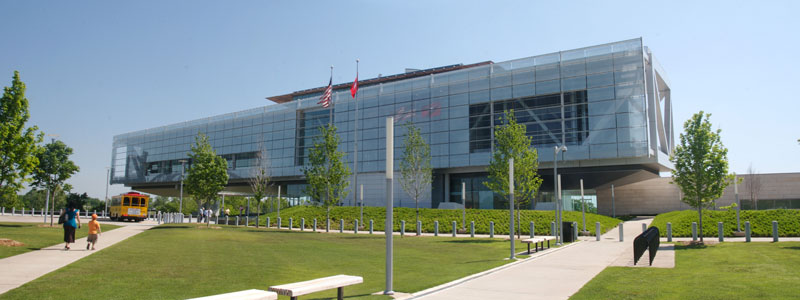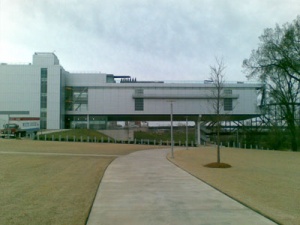William J. Clinton Presidential Center and Park
The William J. Clinton Presidential Center and Park located at 1200 East President Clinton Avenue is the home of the Clinton Presidential Library, the Clinton School of Public Service, and the Clinton Public Policy Institute. The Library was funded by the William J. Clinton Foundation. The Presidential Center and Park is located on an old 27.2 acre industrial brownfield just east of the I-40 ramp and River Market District on the south bank of the Arkansas River in Little Rock.
All of the buildings on the site, except the renovated Choctaw Railway Station, were designed by New York architects James Polshek and Richard Olcott. The total floorspace in all Clinton Presidential Center buildings is 152,000 square feet, or about 3.5 acres.
The Clinton Presidential Center is the most expensive privately-funded construction project in Little Rock history. More than 112,000 people made donations to defray the $165 million in construction costs for the presidential center complex. The names of many of these donors are etched in commemorative bricks and 12"x6" granite blocks outside the main entrance to the museum. Regular upkeep of the facilities - estimated at $4 million in the first year of operation - is supported by an endowment of $7.2 million and regular funds of the National Archives and Records Administration. Entry fees pay for public programs.
The Clinton Foundation has logged approximately 800,000 official visits to the Clinton Library in the first two years since the Library opening. To encourage visitors, the Foundation has worked to include the Library on the route of regional bus tours to related sites like the National Civil Rights Museum and Graceland in Memphis.
Contents
Clinton Presidential Library
The main building, comprising the Clinton Library Museum and Great Hall, has been variously called a "bridge to the 21st century" (a favorite Clinton expression) as it cantilevers ninety feet out towards the Arkansas River's edge, and as the "presidential double-wide" for its color, shape, and association with a president from small-town Arkansas. The Library is essentially a long, rectangular box elevated forty feet off the ground. A two-story veranda is attached to three sides of the building.
Foundation chairman Skip Rutherford noted that Bill Clinton and the architects created the building to meet four specific goals: longterm architectural significance, environmental sensitivity, tourism potential, and economic revitalization of a declining warehouse district. Clinton has noted that the building represents "the first green Presidential Library, featuring solar panels and other improvements that have enabled us to cut energy usage by more than 30 percent. ... [I]t is simply breathtaking, especially when lit up, with its sparkling glass frame, river backdrop, and visibility to people driving by on the interstate."
Architectural critic Nicolai Ouroussoff has written that the library building evinces "a firm grasp of local vernacular traditions, from decaying industrial bridges to the rickety shotgun shacks that are a haunting emblem of the old South." Ouroussoff believed that Polshek's plans fell short, however, as the Library architecture did not "tap into the psychological complexity or political nuances that made Bill Clinton one of the most fascinating characters of our era - the charisma, the supple mind, the populist touch."
The building and its architect were recipients of the prestigious 2006 Institute Honor Award for Architecture. The American Institute of Architects awards committee noted that the building invoked "a different vocabulary for a presidential library."
By far the most popular attraction at the Clinton Presidential Center is the 20,000 square feet of museum exhibits. Visitors are reminded to first visit the 80-seat orientation theater, which includes an endlessly repeating film documenting Clinton's life and work. Gigantic cherry bookcases housing about three percent of all Clinton administration papers frame 20,000 square feet of museum space found on the main and upper levels. One hundred and ten feet of oversize interactive displays designed by Ralph Appelbaum Associates stand at angles in the center of the exhibit space. The displays are surrounded by thirteen policy alcoves also created by Appelbaum. The upper level features the Life in the White House exhibit, the Music Room, a temporary exhibit room, and a scale model of the Oval Office painstakingly recreated by Kaki Hockersmith. The library houses some 77,000 artifacts on site, though only a fraction are on exhibit at any given time. The current charge for visiting the museum exhibits is $7 for adults.
The Clinton Library Archives are housed at the Clinton Presidential Center in Little Rock, Arkansas, and administered by 11 staff archivists from the National Archives and Records Administration. The archives include approximately 35,000 cubic feet of material. This material includes 77 million pages of documents, 1.8 million photographs, 88,000 rolls of film, 12,500 videotapes, and assorted electronic files. Also in the archives are 14,000 books from Clinton's personal library.
Café 42 is a restaurant located in the Clinton Library at 1200 President Clinton Avenue. Café 42 officially opened for business on November 22, 2004. Café 42 chef James Hughes offers up fried alligator bites and reuben sandwiches. The restaurant offers regular jazz performances, a Sunday brunch and buffet, and a lunchtime salad bar.
The Clinton Library apartment is a 5,000 square foot glass-walled "executive suite" located atop the Clinton Library in downtown Little Rock, Arkansas. The apartment has been compared to Mies van der Rohe's Farnsworth House. Kaki Hockersmith designed the interior space of the apartment.
The Clinton Library Great Hall and Terrace is located on the south end of the Clinton Library. The Great Hall can seat 220 people for banquets or 400 for concert performances.
Clinton School of Public Service
The Clinton School of Public Service is an educational institution affiliated with the University of Arkansas system. The School is located in Sturgis Hall at Choctaw Station on the grounds of the Clinton Presidential Center in Little Rock, Arkansas. The first dean of the Clinton School of Public Service was former U.S. Senator David Pryor. The Clinton School offers a two year program culminating in a master's degree in public service. Masters of Public Service degree. Bill Clinton, who often spoke of the "nobility of public service" during his presidency, helped design the curriculum for the school. Some parts of the program are modeled after Boston's John F. Kennedy School of Government.
Sturgis Hall is a building on the grounds of the William J. Clinton Presidential Center and Park. It houses both the Clinton School of Public Service and the Clinton Public Policy Institute. Sturgis Hall is located in the old Choctaw Railway Station, which was renamed in honor of the Trust of Roy and Christine Sturgis, which paid for the station's renovation effort.
James L. (Skip) Rutherford is William J. Clinton Professor and Dean of the University of Arkansas Clinton School of Public Service (May 2006-present). Rutherford is past chairman (1997-2006) of the nonprofit William J. Clinton Foundation, which oversaw construction of the Clinton Presidential Center.
Clinton Public Policy Institute
Building Architecture and Design
The elevated design of the building meant that wind uplift was a concern. A model of the building had to be tested in a wind tunnel. The Polshek Partnership solved the problem of solar gain on the west side of the building by adding the "front porch."
See
- Ceilings Plus
- Cerami and Associates
- Cline Bettridge Bernstein Lighting Design
- Leslie E. Robertson Associates
- McClelland Consulting Engineers
- Polk Stanley Rowland Curzon Porter Architects
- Polshek Partnership
- Poulin+Morris Design Consultants
- Ralph Appelbaum Associates
- Siemens Building Technologies
- Steven Winter Associates
Building Construction
See
- CDI Contractors
- ClintonCam
- Doyne Construction Company
- Flack+Kurtz
- Phelps Program Management
- Pilkington glass
Site Selection, Landscape Architecture, and Remediation
On February 13, 1997, Clinton made public his selection of Little Rock as the site for his library over Fayetteville, Hot Springs, North Little Rock, and Hope. About thirty local sites in Little Rock were in the running as potential locations for the presidential center. A site near the Cathedral School was rejected because of high voltage overhead electrical wires and bustling train activity. An area east of the Arkansas Arts Center was eliminated because exit ramps were too short for tour buses to negotiate. The Crystal Hills neighborhood of North Little Rock was excluded on the grounds that it was too remote.
The Presidential Center Park sits on a former waterfront warehouse district in downtown Little Rock. Prior to its purchase for $16.5 million by the City of Little Rock, the site was in the hands of eleven separate landowners. The City issued bonds to be paid off by a 50 percent hike in public golf course greens fees and an increase in Little Rock Zoo ticket prices to pay for the various tracts of land. George Hargreaves is the designer of the landscaped park surrounding the buildings of the Clinton Presidential Center. All of the parkland is maintained by the City of Little Rock.
See also
- Clinton burial site
- Dan Euser Waterarchitecture
- Grubbs, Hoskyn, Barton & Wyatt
- MDL
- Millennium Trail
- Moffatt and Nichol Engineers
- Play Site Architecture
- Rock Island Bridge
- Time capsule
See also
- Entek Engineering
- LEED certification
- Library opening
- William Jefferson (Bill) Clinton
- Little Rock River Market
References
- Fred Bernstein, "Archive Architecture: Setting the Spin in Stone," New York Times, June 10, 2004.
- "Clinton Library Jump-Starts Downtown Little Rock," American Libraries, 34.2 (February 2003): 23.
- Kira L. Gould, "Glassy, Open Clinton Presidential Center to 'Put Things in the Light,'" Architectural Record 189.2 (February 2001): 31.
- Edward Klump, "Clinton Center Adds to District's Flowering River Market Area; Took Vision, Time," Arkansas Democrat-Gazette, November 14, 2004.
- Edward Klump, "Little Rock Rode High on Tourism During '05," Arkansas Democrat-Gazette, February 3, 2006.
- Cathleen McGuigan, "Bill's New Bridge," Newsweek, September 13, 2004.
- Nicolai Ouroussoff, "Architecture Review: William J. Clinton Presidential Center an Earnest Building for a Complex President," New York Times, November 25, 2004.
- Jill Zeman, "Clinton Center's Design Lauded; Library One of 30 Buildings to Receive Architecture Group's Award," Arkansas Democrat-Gazette, January 14, 2006.


